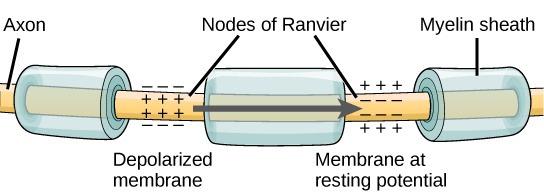Neurons can transmit signals at astonishing speeds - some signals can travel as fast at 268 miles per hour! How are neurons capable of such speeds?
Well, their axons, which transmit signals to other neurons, have a special covering known as the myelin sheath. Myelin, a lipid-rich substance, insulates the axon and increases the speed of signal transmission. As an action potential travels down the axon, some ions may cross the membrane and exit the cell. However, the presence of myelin prevents this escape.
In the peripheral nervous system, myelin is found in the membranes of Schwann cells, a type of glial cell. Each Schwann cell forms one unit of myelin. In the central nervous system, oligodendrocytes, another type of glial cell, tightly wrap around the axon to form several layers of insulation. Each process of an oligodendrocyte can form one segment of myelin for several different cells.

Myelin is not the only special feature of neurons that accelerates signal speeds. There are gaps between the myelin sheath, known as the Nodes of Ranvier, that have voltage-gated ion channels. The action potential dissipates as it travels along the myelinated portion of axon. However, the inflow of electrical charge from the incoming action potential triggers the opening of the voltage-gated channel in the Nodes of Ranvier. This influx of ions coming in through the channel boosts the signal and therefore enables the action potential to travel rapidly along the axon. The signal appears to "jump" across the Nodes of Ranvier and thus this process is known as saltatory conduction, from the Latin word saltare "to jump".
________
Image Credit:
(1)“OligodendrocyteNS.” Wikimedia Commons, 4 May 2019, upload.wikimedia.org/wikipedia/commons/f/f2/OligodendrocyteNS.png.
(2) “Nodes of Ranvier.” Wikimedia Commons, 27 May 2016, upload.wikimedia.org/wikipedia/commons/5/53/Figure_35_02_05.jpg.
Well, their axons, which transmit signals to other neurons, have a special covering known as the myelin sheath. Myelin, a lipid-rich substance, insulates the axon and increases the speed of signal transmission. As an action potential travels down the axon, some ions may cross the membrane and exit the cell. However, the presence of myelin prevents this escape.
In the peripheral nervous system, myelin is found in the membranes of Schwann cells, a type of glial cell. Each Schwann cell forms one unit of myelin. In the central nervous system, oligodendrocytes, another type of glial cell, tightly wrap around the axon to form several layers of insulation. Each process of an oligodendrocyte can form one segment of myelin for several different cells.

Myelin is not the only special feature of neurons that accelerates signal speeds. There are gaps between the myelin sheath, known as the Nodes of Ranvier, that have voltage-gated ion channels. The action potential dissipates as it travels along the myelinated portion of axon. However, the inflow of electrical charge from the incoming action potential triggers the opening of the voltage-gated channel in the Nodes of Ranvier. This influx of ions coming in through the channel boosts the signal and therefore enables the action potential to travel rapidly along the axon. The signal appears to "jump" across the Nodes of Ranvier and thus this process is known as saltatory conduction, from the Latin word saltare "to jump".
________
Image Credit:
(1)“OligodendrocyteNS.” Wikimedia Commons, 4 May 2019, upload.wikimedia.org/wikipedia/commons/f/f2/OligodendrocyteNS.png.
(2) “Nodes of Ranvier.” Wikimedia Commons, 27 May 2016, upload.wikimedia.org/wikipedia/commons/5/53/Figure_35_02_05.jpg.

Comments
Post a Comment